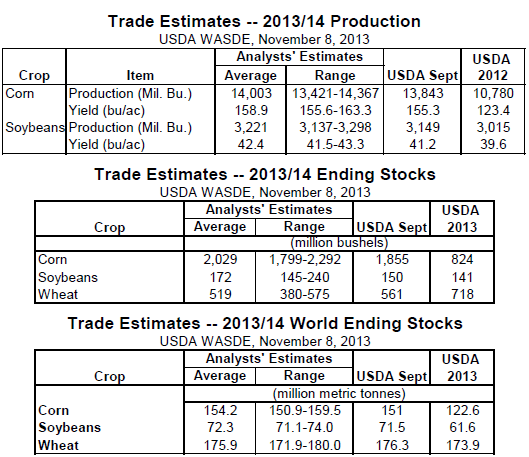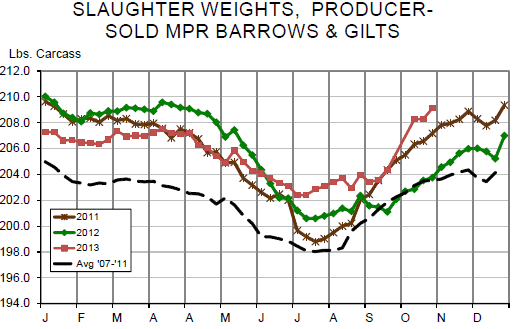



CME: Hog Weights Exploded During Govt Shutdown
US - Grain markets finally got another benchmark on 2013-14 supplies last week when USDA released its World Agricultural Supply and Demand Estimates (WASDE) for November, write Steve Meyer and Len Steiner.The report will be published at 12:00 EST/11:00 CST. The tables at right show the ranges and averages for analysts’ pre-report estimates as well as USDA’s September WASDE estimates. Recall that the October WASDE report was a casualty of the federal government shutdown.
The estimates, quite logically, fit with the bearish sentiment among traders in recent weeks. Analysts, on average expect higher yields and, consequently, total crops for both corn and beans this year with the corn crop exceeding 14 billion bushels. The average predicted yield of 158.9 bushels per acre would be only 1.3 bushels below the 1960-2012 trend value for this year. The projected average soybean yield of 42.4 bushels per acre would still be nearly 2 bushels per acre below that crop’s long-term trend.
Note that the average estimates for corn production and yield imply 88.12 million harvested acres. That is nearly 1 million fewer than USDA had in its September report and is a figure that still looks high relative to FSA planted and prevented planting data. USDA normally adjusts acres from its June estimate levels in the October report so this is a shutdown-delayed first glimpse at “actual” numbers.
Analysts expect USDA, quite logically, to reflect larger corn and soybean crops in higher estimated year-end stocks. The average estimate for corn stocks next fall is even above the “magic” 2 billion number for the first time since 2005. 2014 would be the first year since 2011 with a year-end carryout of over 1 billion bushels. Note that analysts do expect USDA to reduce year-end wheat stocks from September’s 561 million bushels to 519 million bushels. Further, those stocks are significantly (28 per cent) lower than in 2012.
Our discussion of the hog supply situation was, primarily due to space limitations, missing one important piece — hog weights. As can be seen below last year’s “steady as she goes” marketing weights during the late summer and fall months are a thing of the distant past! Weights for producer-sold barrows and gilts reported under USDA’s mandatory price reporting system exploded during the government shutdown and exceeded 209 pounds last week. These animals average carcass weight yesterday was 210.4 pounds. It appears likely that this week’s average will exceed 210 pounds. If so, the year-on-year increase in weights would be 2.6 per cent from last year’s 204.6. That kind of increase would make up for most of the shortfall in numbers and leave production very close to 2012 levels.
As can be seen from last week’s increase and penciling in a value north of 210 for this week, this fall’s weight increases have been about as extraordinary on the top side as last fall’s lack of increases were on the bottom side. These increases would suggest that there are hogs that can be moved to slaughter at a faster clip, an action that would pull down weights and push slaughter higher. But a main driver is — surprise, surprise — profitability. Our model says hogs sold in October cost about $92/cwt carcass to produce. That figure drops to $90 in November and $85 in December. And those are average costs which are almost certainly higher than marginal cost of those last few pounds of gain. Falling hog prices may, however, provide some incentive to move pigs quicker with the result being more hogs and a slower rate of increase for weights. That usually happens in November — but will it this year?








